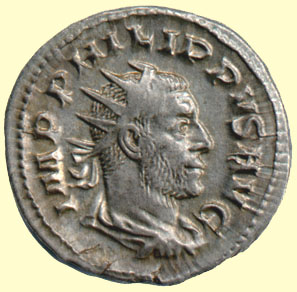 Contents -
Previous Article -
Next Article
Contents -
Previous Article -
Next Article
The years between A. D. 235 and 284 were known as the period of military anarchy or simply as the period of the Barracks Emperors. Ever since the Praetorian Guard had murdered Caligula and set Claudius up as emperor in his place, the army found that it could control the empire and set up a new emperor when they grew tired of the old one. Most of the emperors throughout the Flavian, Antonine and Severan periods which lasted from A. D. 79 through A. D. 235 had been strong enough to resist the Praetorian Guard's attempts to rule the empire in this way. Two notable exceptions were Didius Julianus. After having murdered Pertinax, the Praetorians actually auctioned off the empire to the highest bidder! Didius Julianus outbid the next lower bidder and purchased the throne by offering a bonus of 25,000 sestertii per man.
After the murder of Severus Alexander in 235, the empire went through a period of almost continuous civil war and campaigns against barbarian attacks which lasted until Aurelian restored order between 273 and 275. Some emperors held the throne for a few years, some only for a few days. Often, the Praetorian Guard put one of its favorites on the throne only to become dissatisfied with him later and choose another candidate. The most common method of death for an emperor of this period was to be stripped of his purple robes and stabbed to death by a group of mutinous soldiers wielding short swords and daggers. Often, they cruelly ridiculed their victim and inflicted unnecessary suffering by dragging him along the ground and stabbing him in such a way as to wound and inflict pain but not to kill. When death finally came, it was usually a stroke of mercy. The bleeding, naked body was often thrown out in the street in full view of the public in order to instill fear into the population, discouraging them from raising a hand against the murderous will of the impudent soldiers. Even many emperors who were good generals and popular with the army were still murdered by the soldiers or a small group of their officers. Of course, when any new emperor ascended the throne he made sure to pay the soldiers a large bonus. This pattern of murder and military rule by the Guard was to remain until the reign of Diocletian. Diocletian was put on the throne by the Praetorians after Carus, the emperor before him was murdered by his Praetorian Prefect, Aper. Diocletian realized that the empire had grown too large to be ruled by one man. He broke each of the large provinces up into several smaller dioceses and gave the military authority and civil authority to two different men. He also divided the empire into eastern and western parts and appointed Maximianus as co-emperor with him to rule in the West. These reforms, as well as the reforms made by Constantine after him brought the period of military anarchy to an end, resulting in a renewed, stronger empire that remained powerful for another 115 years in the West and lasted another 1180 years in the East.
Go to next article:
Go back to previous article: